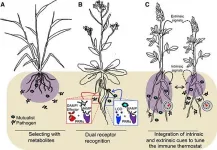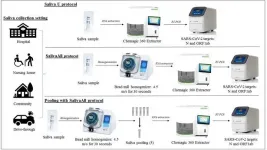Cell Phone Use While Driving May Be Tied to Other Risky Road Behaviors in Young Adults
Pattern of risky driving practices associated with impulsivity, including speeding and running red lights
2021-06-10
(Press-News.org) Philadelphia, June 10, 2021 - A new study from researchers at Children's Hospital of Philadelphia (CHOP) and the University of Pennsylvania's Annenberg Public Policy Center found that 18- to 24-year-olds who use cell phones while driving are more likely to engage in other risky driving behaviors associated with "acting-without-thinking," a form of impulsivity. These findings suggest the importance of developing new strategies to prevent risky driving in young adults, especially those with impulsive personalities. The study was recently published in the International Journal of Environmental Research Public Health.
Cell phone use while driving has been linked to increased crash and near-crash risk. Despite bans on handheld cell phone use while driving in many states, crash reduction results are inconsistent. One explanation may be that those who use cell phones while driving are more likely to engage in other intentionally risky behaviors. Instead of solely addressing the use of cell phones while driving, the authors suggest training young drivers to avoid all risky behaviors associated with impulsivity and sensation seeking.
"This study found that frequent cell phone use while driving was only one indicator of a more general pattern of risky driving practices associated with prior crashes in young drivers," said lead study author Elizabeth Walshe, PhD, a research scientist at the Center for Injury Research and Prevention (CIRP) at CHOP and co-leader of CHOP's Neuroscience of Driving research program. "Assessment of personality traits, such as impulsivity and sensation seeking, may be helpful to identify drivers most at risk in order to provide more targeted interventions promoting safe driving."
This retrospective study recruited 384 young drivers from across the U.S. to complete an online survey measuring risky driving practices - including cell phone use - as well as history of crashes and impulse-related personality traits. The study found that 44.5% of drivers reported being in at least one crash, and 73% of them reported cell phone use while driving. Those who used cell phones while driving were also more likely to participate in other risky driving behaviors, including ignoring speed limits, aggressively passing vehicles going in the same direction, and running red lights. The use of cell phones was not uniquely associated with prior crashes but was one of several risky activities related to crashes.
"It may be useful to treat cell phone use while driving as part of a group of risky driving behaviors, such as driving while impaired by alcohol," said study co-author Dan Romer, PhD, research director of the Annenberg Public Policy Center of the University of Pennsylvania and a senior fellow at CIRP. "For example, messages to enhance driver safety might focus on a larger range of hazardous practices that place the driver and others at risk rather than citing only one, like cell phone use."
INFORMATION:
This work was supported by the Annenberg Public Policy Center of the University of
Pennsylvania and the Center for Injury Research and Prevention at Children's Hospital of Philadelphia.
Walshe et al, "Rethinking Cell Phone Use While Driving: Isolated Risk Behavior or a Pattern of Risk-Taking Associated with Impulsivity in Young Drivers?" Int J Environ Res Public Health, online May 25, 2021. DOI: 10.3390/ijerph18115640.
About Children's Hospital of Philadelphia:
Children's Hospital of Philadelphia was founded in 1855 as the nation's first pediatric hospital. Through its long-standing commitment to providing exceptional patient care, training new generations of pediatric healthcare professionals, and pioneering major research initiatives, Children's Hospital has fostered many discoveries that have benefited children worldwide. Its pediatric research program is among the largest in the country. In addition, its unique family-centered care and public service programs have brought the 595-bed hospital recognition as a leading advocate for children and adolescents. For more information, visit http://www.chop.edu.
ELSE PRESS RELEASES FROM THIS DATE:
2021-06-10
Plants are constantly exposed to microbes: pathogens that cause disease, commensals that cause no harm or benefit, and mutualists that promote plant growth or help fend off pathogens. For example, most land plants can form positive relationships with arbuscular mycorrhizal fungi to improve nutrient uptake. How plants fight off pathogens without also killing beneficial microbes or wasting energy on commensal microbes is a largely unanswered question.
In fact, when scientists within the field of Molecular Plant-Microbe Interactions were asked to come up with their Top 10 Unanswered Questions, the #1 question was "How do plants engage with beneficial microorganisms while at the same time restricting ...
2021-06-10
MORGANTOWN, W.Va. -- Imagine being woken up at 3 a.m. to navigate a corn maze, memorize 20 items on a shopping list or pass your driver's test.
According to a new analysis out of West Virginia University, that's often what it's like to be a rodent in a biomedical study. Mice and rats, which make up the vast majority of animal models, are nocturnal. Yet a survey of animal studies across eight behavioral neuroscience domains showed that most behavioral testing is conducted during the day, when the rodents would normally be at rest.
"There are these dramatic daily fluctuations--in metabolism, in immune function, in learning and ...
2021-06-10
Philadelphia, June 10, 2021 - The collection of nasopharyngeal swab (NPS) samples for COVID-19 diagnostic testing poses challenges including exposure risk to healthcare workers and supply chain constraints. Saliva samples are easier to collect but can be mixed with mucus or blood, and some studies have found they produce less accurate results. A team of researchers has found that an innovative protocol that processes saliva samples with a bead mill homogenizer before real-time PCR (RT-PCR) testing results in higher sensitivity compared to NPS samples. Their protocol appears in The Journal of Molecular Diagnostics, published by Elsevier.
"Saliva as a sample type for COVID-19 testing ...
2021-06-10
WASHINGTON, June 10, 2021 -- The demand for flexible wearable electronics has spiked with the dramatic growth of smart devices that can exchange data with other devices over the internet with embedded sensors, software, and other technologies. Researchers consequently have focused on exploring flexible energy storage devices, such as flexible supercapacitators (FSCs), that are lightweight and safe and easily integrate with other devices. FSCs have high power density and fast charge and discharge rates.
Printing electronics, manufacturing electronics devices and systems by using conventional printing techniques, has proved to be an economical, simple, and scalable strategy for fabricating FSCs. Traditional micromanufacturing ...
2021-06-10
An exploratory investigation into the behavior of materials with desirable electric properties resulted in the discovery of a structural phase of two-dimensional (2D) materials. The new family of materials are electrides, wherein electrons occupy a space usually reserved for atoms or ions instead of orbiting the nucleus of an atom or ion. The stable, low-energy, tunable materials could have potential applications in nanotechnologies.
The international research team, led by Hannes Raebiger, associate professor in the Department of Physics at Yokohama National University in Japan, published their results on June 10th as frontispiece in Advanced Functional Materials.
Initially, the team ...
2021-06-10
Researchers from Skoltech have designed and conducted experiments measuring gas permeability under various conditions for ice-containing sediments mimicking permafrost. Their results can be useful both in modeling and testing techniques for gas production from Arctic reservoirs and in tracing methane emission in high latitudes. The paper was published in the journal Energy&Fuels.
Permafrost, even though it sounds very stable and permanent, is actually quite diverse: depending on the composition of the frozen ground, pressure, temperature and so on, it can have varying properties, which are extremely important if you want to build something on permafrost, ...
2021-06-10
GRAND RAPIDS, Mich. (JUNE 10, 2021) -- Much like a supply truck crossing the countryside, the misfolded proteins that damage neurons in Alzheimer's disease travel the "roads" of the brain, sometimes stopping and sometimes re-routing to avoid roadblocks, reports a study published in END ...
2021-06-10
MELVILLE, N.Y., June 10, 2021 -- The physiological impacts of COVID-19 seem almost limitless. Complications can range from loss of taste to respiratory distress, with many effects lasting for months. Evidence suggests auditory and vestibular effects should be added to the growing list of symptoms.
During the 180th Meeting of the Acoustical Society of America, which will be held virtually June 8-10, Colleen Le Prell, from the University of Texas at Dallas, will talk about hearing and balance disorders associated with coronavirus infection and how pandemic-related stress ...
2021-06-10
Paris, France and New York, NY June 10, 2021 - AP-HP Greater Paris University Hospitals, the leading European clinical trial center with the largest amount of healthcare data in France dedicated to research and Owkin, a startup pioneering Federated Learning and AI technologies for medical research and clinical development, announced the recent results of their ongoing strategic collaboration at ASCO 2021. The abstract and poster entitled "Identification of pancreatic adenocarcinoma molecular subtypes on histology slides using deep learning models" demonstrates the first ...
2021-06-10
ROCKVILLE, Md. - June 10, 2021 - The Association for Molecular Pathology (AMP), the premier global, molecular diagnostic professional society, today published consensus recommendations to aid in the design and validation of clinical CYP2D6 assays, promote standardization of testing across different laboratories and improve patient care. The manuscript, "Recommendations for Clinical CYP2D6 Genotyping Allele Selection: A Joint Consensus Recommendation of the Association for Molecular Pathology, College of American Pathologists, Dutch Pharmacogenetics Working Group of the Royal Dutch Pharmacists Association, and European Society for Pharmacogenomics and Personalized Therapy," was released online ahead of publication in The Journal ...
LAST 30 PRESS RELEASES:
[Press-News.org] Cell Phone Use While Driving May Be Tied to Other Risky Road Behaviors in Young Adults
Pattern of risky driving practices associated with impulsivity, including speeding and running red lights




